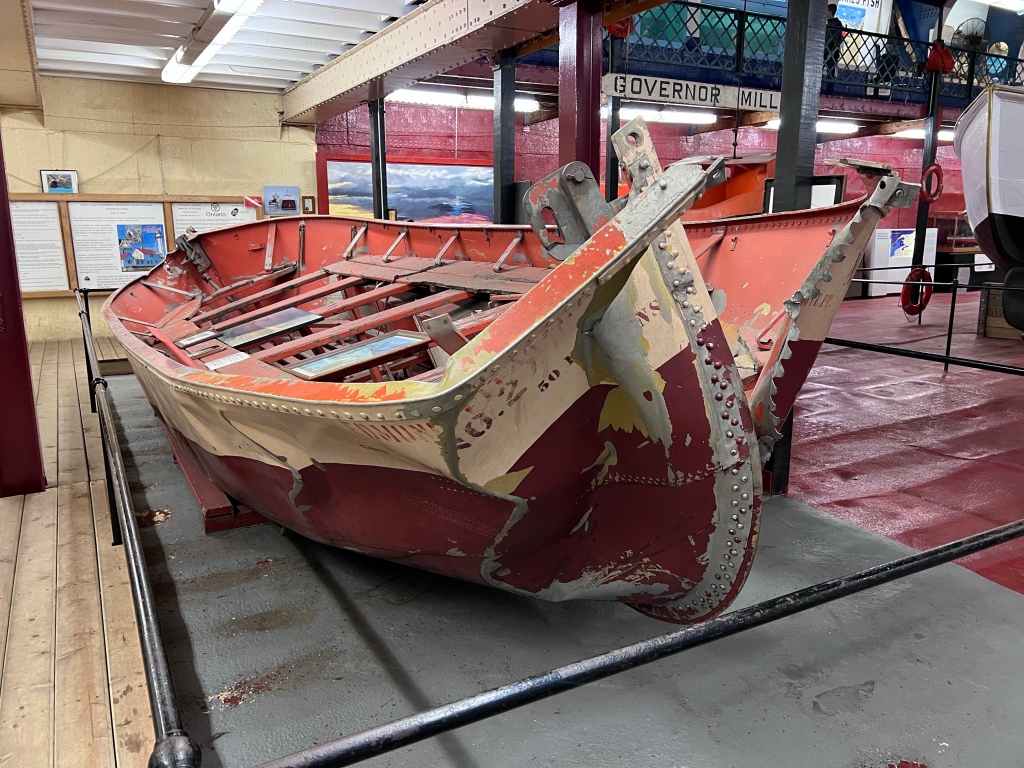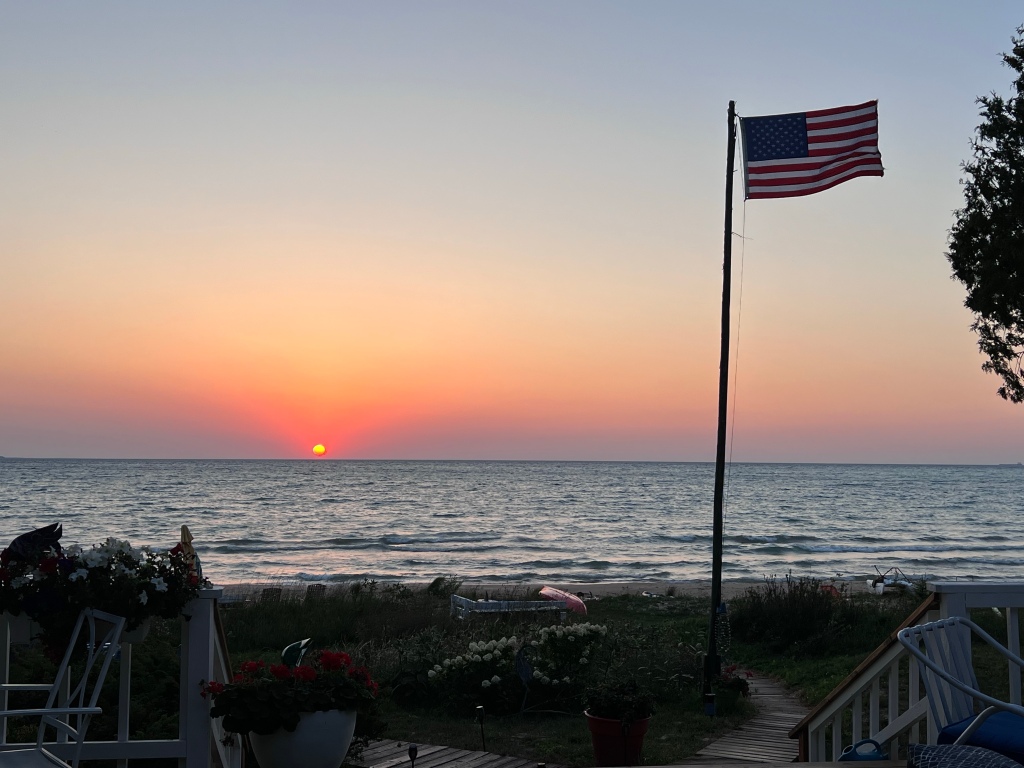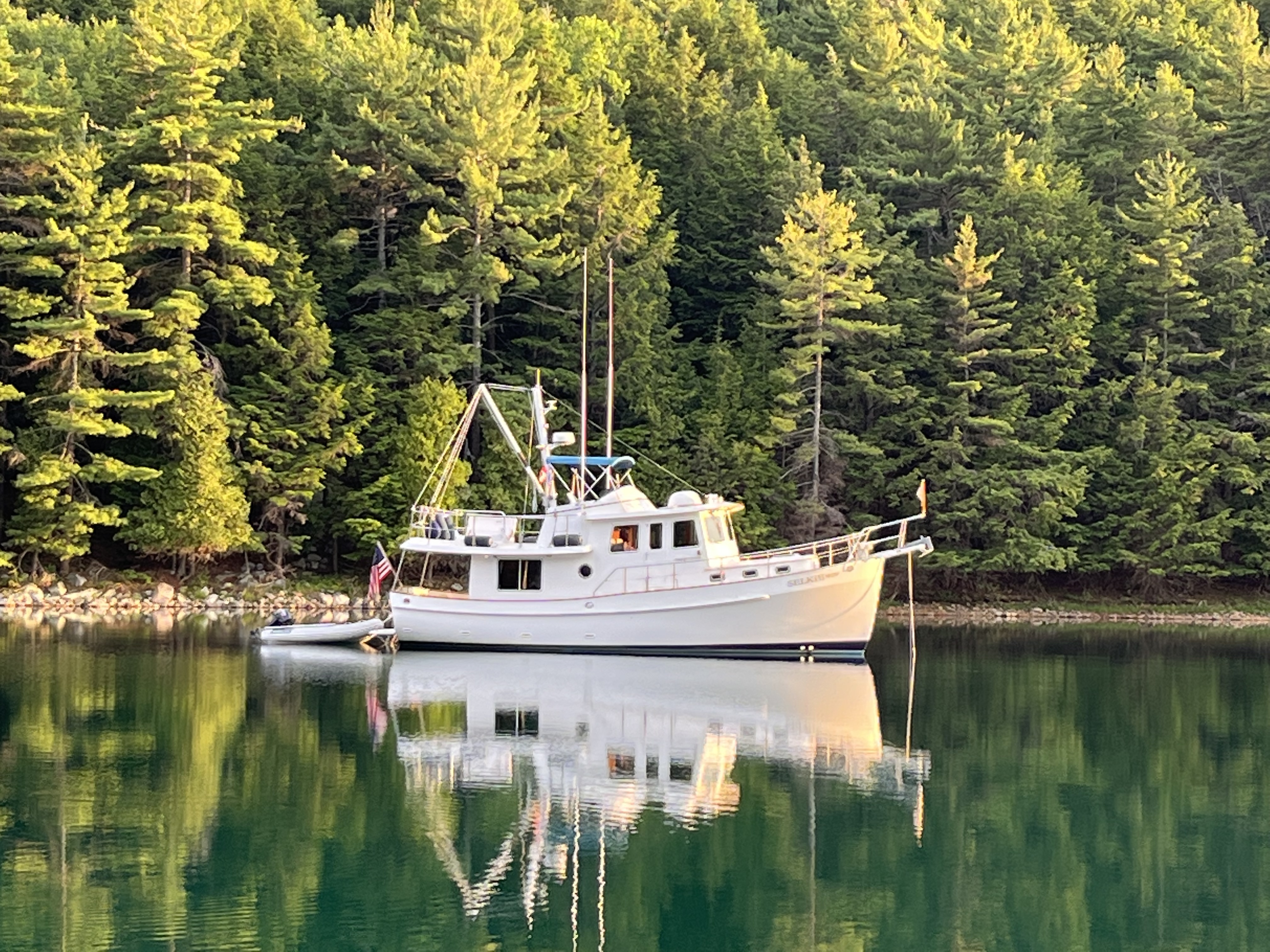Our focus for the past few days had been to head westbound through the north channel to the United States.

We estimated we needed to be in Sault Ste. Marie, Michigan to pass through Customs by the 29th or 30th of August. We needed to stay on track with our goal to be in Waukegan Illinois by the 16th or 17th of September.
We still had a long way to go, including a desire to explore Door County in northern Wisconsin.
We needed to import our dinghy from Canada into the United States. We had bought it last year in Midland Ontario, and realize that we need to officially import it into the US to register it in the state of Michigan.
We’d alerted Customs to our impending arrival so that they could schedule somebody to come and visit us and give us the paperwork for the dinghy.
Before we left our Anchorage the night before in Canada, I went to the CPB Roam app and entered all of our passport information along with Selkie’s legal information so that we could come across the border.
We declared that we had some vegetables and meat products on board as part of our normal kitchen stock that we would have in the fridge and in the cupboards. Even though some of these items were restricted according to the Customs website, I declared them.
Once I had entered all that information into the app, I looked for a place to save it, so I wouldn’t have to re-enter it the next day.

There was a button to press, so I pressed it.
Suddenly the app said “Waiting for customs officer to review data.”
I thought to myself, “Will they let me check in before I come out of Canada into the US?”
I waited a minute. Another message said that I would be interviewed through a video conference by a Customs official.
I started to get a little nervous.
After about a couple more minutes, the app said, “Welcome to the US. You’ve been cleared to enter.”
I didn’t have to talk to anybody; they just let us in with all of our information that I’ve entered in the app.
Even the declared restricted stuff wasn’t an issue for the Customs folks.
We were back in the US, even though we were not quite there yet.
The next morning, we pulled up anchor, came out of our little anchorage, and made a right turn to enter the US.
Our destination was Sault Saint (Ste.) Marie, Michigan. “Sault” is pronounced “Soo”.
“The Soo”, as the locals call the area, includes the towns with the same name on both sides of the US and Canadian border.
The Soo was first visited by Europeans around 1615.
Today it remains a vital transportation hub at the base of Lake Superior, funneling goods and services to the lower Great Lakes from Lake as it was first done by the American Indians thousands of years ago.
In the 1970’s more gross tonnage was shipped through the locks at the Soo than the Panama Canal.
There are lots of websites speaking to the history of the area. I chose the following to copy, with the hyperlink imbedded in the first line of the paragraph below.
“Sault Ste. Marie is the oldest city in Michigan, and among the oldest cities in the United States. Over the course of our history, the flags of several sovereign nations have flown over the Sault.
“Over 2,000 years ago, Native Americans began to gather here for the wealth of fish and fur found along the rushing waters of the wide, turbulent river that linked the Great Lakes of Superior and Huron. Spring and Fall were important seasons for these original settlers, and they called the area “Bahweting,” or, “The Gathering Place.”
“While there is some debate on the exact meaning of ‘Sault,’ scholars of early French note that the word translates into jump, referring to the place where one needs to “jump”, or put into the St. Mary’s River. This translation relates to the treacherous rapids and cascades that fall 21 feet from the level of Lake Superior to the level of the lower lakes.
“Hundreds of years ago, this prohibited boat traffic and necessitated an overland portage from one lake to the other.
“Due to the strategic location of the river and the abundant natural resources found here, the French and British often fought over the area and the right to trade with Native Americans in the 1700’s.
“In 1820, the Treaty of the Sault was signed, which turned control over to the United States in 1823.
Heading up to St. Mary’s River to the Soo, we passed several large ships heading down the St.Marie’s River,. We had to be on our toes to not get in their way as the navigation channels are barely big enough to fit these big ships in. The ships that passed us were representative of the commerce in the Great Lakes

American Century, a US Flagged ship, is a “thousand footer” as they say, literally over a thousand feet long and built to just fit into the biggest locks at the Soo. If they had made the locks 1200 feet long, they would have made these thousand footers twelve hundred feet long. These carriers carry most of the taconite iron ore and limestone to the steel mills around the Great Lakes.

The second ship passing us was the Evan’s Spirit. The Evans Spirit, a Canadian flagged ship, is a modern ship, used for general bulk cargo around the lakes.

Lake Guardian is a US flagged survey and scientific ship.

Federal Champlain is another bulk carrier, and an ocean going ship flagged in the Marshal Islands

Philip R Clark is a more traditional ore carrier with a pilot house in the front of the ship and an engine room in the stern. Her sister ship, the Arthur M Anderson, was the freighter that the last to speak with the Wdmund Fitzgerald that fateful night in November, 1979 before “The Fitz” sunk in Lake Superior.
A side note: this class of freighter is powered by Westinghouse Steam Turbines, one of my old employers. Although I never actually got on one, I worked in the group that serviced these ships.

We docked successfully at George Kemp Marina. The winds were forecasted to increase during the afternoon and evening.

I had made arrangements with the customs officials to come to Selkie to do the dinghy inspection, and receive the necessary import paperwork that we needed.
The customs official did swing by. He was very courteous and professional. He had two sets of paperwork for me to sign. I signed both. He took one copy. We shook hands and he left. He didn’t even need to see the dinghy. He just wanted to give us the paperwork.
My uncle and aunt, who live on Neebish Island, were up at the Soo, taking care of some personal business and came over to see us. It was fortunate that they did.
We had the Customs import information from the customs officer, but we need to get to the Michigan secretary of state office to go ahead and register the dinghy.
They drove us out there, where we got the registration and then helped us get the registration numbers that you have to put on the outside of any boat in the state of Michigan, and most other states.
Most importantly I got the registration stickers showing that we had paid through 2026. We then went to a Mexican place close to the marina for lunch and then stop by the American Legion for a beer afterwards.
It was rumored that the drummer from the band The Kinks frequented the American Legion on a regular basis. It would’ve been fun to run into him.
Alas, we did not so we went back to the boat and settled in for the evening.
The next day, Libbie want to do some shopping on the bicycle.
Right next to the marina was an old freighter, called the Valley Camp that was built in 1917, retired, and converted to a museum ship.

The entire hold of this almost 600 foot long ship is the museum. I would highly suggest anybody who happens to be in area of the Soo to stop by for a couple hours and visit.
I easily spent three hours in the place just looking at all the displays. They have one complete life boat and one partial life boat from the wreck of the Edmund Fitzgerald.

They have a lot of other items on display as well and it gives you a good sense of the shipping history of the Great Lakes… even a few thousand years ago.

Libbie returned from her shopping and I rejoin her at Selkie.
We had some work to get done to prepare her for heading south down to Saint Mary’s to Mackinac city where we would stay for a few days.
Our plan in Mackinaw City was to layover for a few days as the weather was going to be bad. We also had family in town, and wanted to hang at the Sheldon compound as well.

For the next part of our journey, we will be going west along Michigan’s Upper Peninsular’s north shore of Lake Michigan. We will then head down on the Wisconsin side of Lake Michigan.
We want to explore Door County as well as a few other places along the way.
We’ve decided not to go down the Michigan side of Lake Michigan. I am pretty familiar with that side of the lake having grown up in Michigan.
The advantage of going on the west side of Lake Michigan is that the winds blow offshore a lot more than they do on the east side.
That characteristic of the weather may come in handy the later in September we go as the storms can be quite disruptive to the best made plans a Looper can make.
More later.

3 replies on “Coming Back into the US”
Sounds wonderful! Happy Labor Day neighbor!
LikeLike
Fun times!!! Never knew it was Soo.. Always assumed ‘salt’. the things you don’t get from print .. thanks for blogging… great adventure!!
LikeLike
Very nice. Love the history, the detail and the pictures.
LikeLike